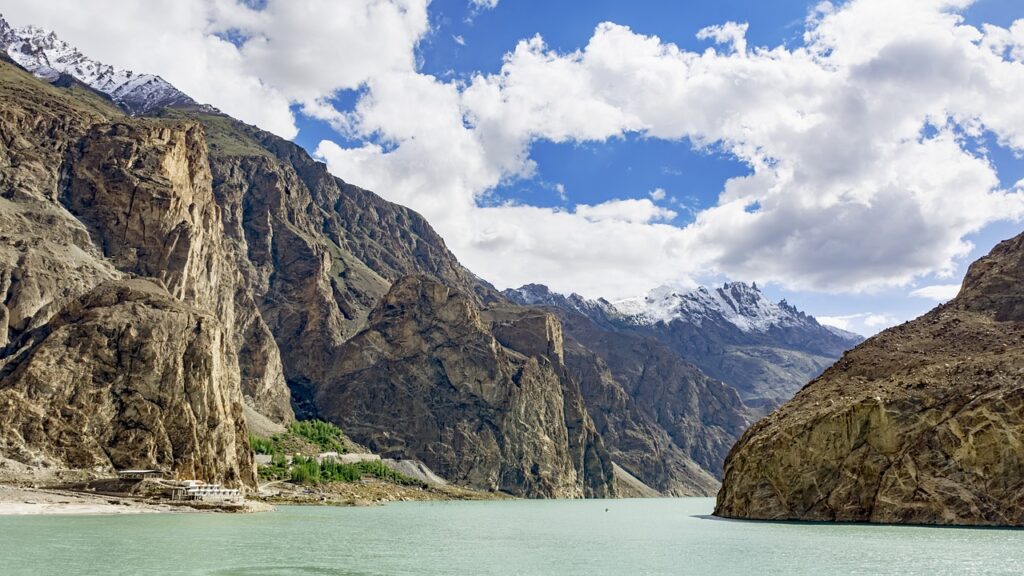Attabad Lake: Complete Travel Guide to Hunza’s Jewel

Attabad Lake: Facts at a Glance
Where: Gojal region, Hunza Valley, Gilgit–Baltistan, Pakistan.
Formation: Created after a massive landslide on 4 January 2010 that blocked the Hunza River.
Length (approx): ~11–14 km (most sources report roughly 13–14 km at peak inundation).
Max depth: reported as ~100 m (100+ m); some local sources quote ~109 m / 358 ft—use “100+ m” as the safe public figure.
Altitude: ~2,500–2,600 m above sea level (Hunza elevation context).
Why visit Attabad Lake — what to expect
If you’re coming for dramatic mountain colors, easy-access boating, and the story-of-nature-turned-tourism, this is it. The lake’s turquoise water set against the Karakoram cliffs is photogenic at almost every angle; it’s also a living reminder of the 2010 disaster that reshaped local life and transport. Activities include boat rides, jet-skiing, trout fishing, and (in winter) natural ice views—though ice activities carry extra risk.
Purpose & value: By the end of this guide you’ll know exactly how to reach the best viewpoints, what to pack, how to book a reliable boat, and how to combine Attabad with Passu, Hussaini Bridge and Karimabad without wasting a day.
How Attabad Lake formed?
A catastrophic landslide at Attabad village on 4 January 2010 dumped millions of cubic meters of rock into the Hunza River, creating a natural dam. The river backed up behind that barrier for months and formed the lake that still exists today. The event killed local residents and forced thousands to move; it also submerged parts of the Karakoram Highway before mitigation works and highway realignment were completed.
Getting there — routes & distances
By road (most common)
From Gilgit to Attabad: ~1.5–2.5 hours depending on stops and traffic; the Karakoram Highway (KKH) is the main route. See local bus/jeep options in Hunza.
From Islamabad to Attabad (by road): ~570–590 km (approx. 10–12 hours drive depending on speed and stops). Flights to Gilgit + road transfer are faster for most travellers.
By air
Fly Islamabad → Gilgit (short domestic hop), then drive via KKH to Karimabad and Attabad. Flights are weather dependent—book with flexible dates.
Best time to visit & weather notes
Best months: April → mid-October for clear lakes and safe road access. Late spring/early summer shows the lake best.
Winter: lake can freeze and the landscape becomes a snow scene — spectacular but roads may close, & ice is not always safe for skating. Check local conditions.
💡 Tip: If you’re planning a photography trip, aim for golden hour at Duikar (sunrise) for reflections and soft light—see the Local Insights section.
Top things to do at Attabad Lake Hunza
1. Boat ride across the turquoise water (must-do)
Where: launch at Shishkat/near Gulmit or designated boat docks. Plan 30–90 minute rides. Book through local operators or hotels in Karimabad.
2. Jet-ski & water sports — available seasonally; negotiate local prices.
3. Trout fishing — ask local operators or guesthouses for permits/guides.
4. Short hikes / viewpoint walks — short switchbacks above the lake give panoramic shots; Duikar and Shishkat are common viewpoints.
5. Combine with Hussaini Bridge & Passu Cones — logical route: Karimabad → Attabad → Passu (see sample itinerary).
Inline FAQ:
Can you swim in Attabad Lake? — Technically yes, but not recommended for casual swimmers due to depth, cold water, and no lifeguard coverage. Use a guide and proper safety gear.
⚠️ Safety callout
Water is deep and cold—always wear life jackets on boats. Boat safety standards vary; choose operators with clear, well-maintained boats. Roads can be narrow and landslide-prone—avoid travel during heavy rain/snow.
Local insights & best photo spots 📍
Duikar: sunrise and expansive lake views—bring telephoto for compressing the passu cones.
Shishkat banks: best for mid-lake boating shots.
Gulmit shoreline: access to cafés and local handicraft stalls (good for human-interest photos).
Pro photographer tip: mid-morning gives saturated turquoise; late evening gives moodier tones. Use a polarizer to cut glare.
💡 Local insight: Ask to stop the boat near a submerged wall/road relic—the “old KKH” makes a powerful before/after photo story.
Suggested itineraries
Half-day (if already in Karimabad)
Drive to Attabad (30–45 mins).
1-hour boat ride (book in advance).
Quick walk to viewpoint + café stop.
Return to Karimabad.
Full-day (Karimabad → Attabad → Passu)
Early depart Karimabad → Attabad.
1–2 hour boat + lakeside lunch.
Drive to Passu Cones (scenic stops) → Hussaini Bridge.
Return after sunset.
2-day adventurous combo
Day 1: Karimabad → Attabad → Gulmit (camp/homestay).
Day 2: Sunrise at Duikar → Passu → Khunjerab (day trip option in season).
Practical tips: boats, prices & negotiation 💡
Ballpark (2024–25 local reports): private boat rides often quoted in PKR — small group boat ~PKR 2,000–3,500 per person depending on length; jet ski extra. Prices fluctuate—confirm on-site.
Booking: Hotels in Karimabad and Gulmit can pre-book reliable boats. For best rates, ask for a licensed operator and life jackets.
Payment: Cash is standard in many places—carry PKR.
- Download or get your 3 shareable itineraries at Attabad lake Hunza Here….
Responsible tourism & community impact
The lake’s creation was tragedy-first, but tourism has brought livelihoods: local handicrafts, homestays, and women-led small enterprises have grown in Hunza with NGO and community support. Respect local customs, avoid single-use plastics at the lakeshore, and book local guides to keep revenue inside the community.
Conclusion
Attabad Lake is both a tourism asset and a living history lesson. For visitors: plan spring → early autumn, book boats via trusted sources, respect safety rules, and aim sunrise at Duikar.
It formed after a massive landslide at Attabad on 4 January 2010 which blocked the Hunza River and created the lake behind the debris.
The lake reached roughly **11–14 km** in length at its largest and **100+ m** depth is commonly reported; local sources sometimes quote ~109 m. Use 100+ m as a safe public figure.
Yes—boating is the most popular activity. Book through local hotels or verified operators and insist on life jackets.
April–mid-October for good road access and color; winter is photogenic but riskier due to snow/ice and possible road closures.
From Gilgit it’s a few hours by road (typical day trip). From Islamabad expect ~10–12 hours by road; flying to Gilgit is faster.
Some visitors report frozen sections suitable for short ice walks, but ice thickness is variable—do not attempt without a local guide and safety checks.
es—guesthouses, themed resorts, and homestays in nearby Karimabad, Gulmit and lakeshore areas. Book ahead in peak season.
Yes—Passu and Khunjerab are in the same broader route, but Khunjerab is typically a longer day trip requiring a separate day due to distance and border formalities.
Most domestic tourists do not need special permits; foreigners should check entry and travel advisories and ensure vehicle permits if driving into restricted areas.
Basic mobile coverage exists around Hunza towns; speeds vary. Don’t rely on realtime services for emergency — download maps and keep local numbers.
Prices vary by season and group size; recent local reports indicate private boat rides ~PKR 2,000–3,500 per person and additional charges for jet-skis. Always confirm current price on arrival.
